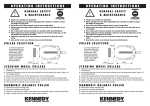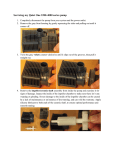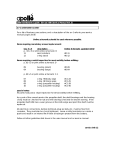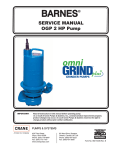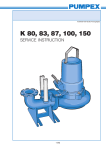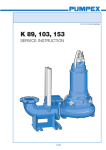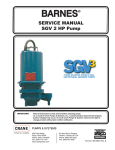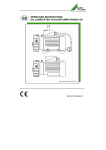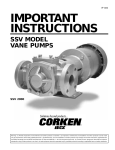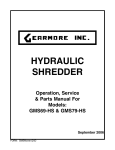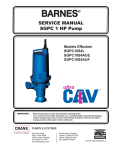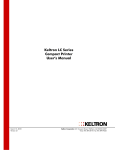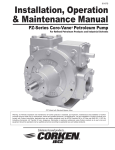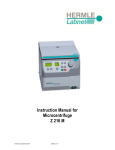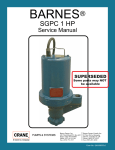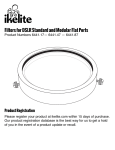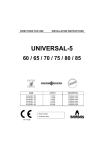Download K 60/63 service instructions
Transcript
K 60, 63 K 60/63.58.0306. Eng/Digital K60-63 SERVICE INSTRUCTION 1 (10) SERVICE INSTRUCTION K 60, 63 K 60/63.58.0306. Eng/Digital This service manual covers the pumps K 60 and K 63 in following designs: Illustrations, e.g. (3/2) indicates the Fig. number using the first digit and the second digit indicates the position on that illustration. Type F Wet Pit Installation Installed on a guide rail system with a quick-release base elbow, the base elbow is bolted to the floor of the sump. The volute is equipped with an adapter to be connected to the discharge elbow. Two twin guide rails are mounted to the discharge elbow to steer the pump into right position when hoisted up and down. Type P, Wet Pit Portable or fixed installation A version of pump which is suitable for temporary or permanent installations. The pump is equipped with a fabricated steel stand and either a threaded (G, NPT) or plain hose connection. When installed the minimum water level in the wet well for continuous operation should not be below half the height of the stator. For intermittent operation the pump should not be used when water level is below the top edge of the pump house. The pumps are divided into three categories: Standard, EX and FM. The difference between the three is the wear plate. In the standard version there is a hole drilled for the moisture switch (optional). On the EX there is no hole and the FM version has a threaded hole. Safety precautions Note: When carrying out any repairs the safety instructions in the Service instruction as in the Installation and Operating Instructions, especially the section ”Safety” must be observed. When carrying out any work correctly sized and adequately dimensioned hoists and other tools should be used. Do not work under a suspended load. Before doing any maintenance or repairs to the pump, make sure that it is isolated from the power supply, and also that no one can reconnect it whilst it is being worked on. When raising the pump, do so by means of a rope or a chain through the handle. Never move or lift a pump by means of its cable. If the pump has been working in sewage or similar effluent, use a power or steam hose to clean the pump before working on it, and observe personal hygiene precautions. Electrical work on the pumps should only be carried out by suitably qualified personnel. General maintenance advice Before assembly all parts should be carefully checked. Parts being reused must be in perfect condition and should be carefully cleaned before fitting. Warning ! The pump and its electrical cables must be disconnected from any power source by a qualified electrician before any inspection or service is performed! Removal from the wet well Hoist the pump from the sump and rinse clean. 2 (10) SERVICE INSTRUCTION K 60, 63 K 60/63.58.0306. Eng/Digital Oil filling and oil change The oil chambers of the PUMPEX submersible pumps have been filled at the works with oil. Oil: 0.48 l nontoxic oil e. g. BP Enerpar M002. A regular oil change is not necessary, provided that the leakage sensor signal is not activated. PUMPEX submersible seal monitoring system (optional) indicates by means of an inspection light that water has entered into the oil and that the mechanical seal is leaking and must be replaced. ATTENTION When using the submersible pump in process or raw water applications an oil which is not injurious to the environment should be used. ATTENTION Waste oil should be disposed of in a proper manner. Oil change on site Note: When carrying out an oil change the regulations covering usage of oil must be observed. Waste oil must be disposed of in a proper manner. Tilt pump so that it lies horizontal. Position oil plug hole at the underside of the pump. Oil is released by unscrewing the oil plug screw (1/1) with sealing washer (1/2) in the volute. The oil will then flow out and into container. It may be slow because oil chamber has not been vented. TIP: To speed up emptying, insert a small bore tube (Ø 3-4mm) deep into oil chamber to aid unrestricted venting. Refilling oil Place motor in position opposite to fig.1, so that oil plug hole faces upwards. Fill in oil slowly, allowing air to vent out through same hole. Check and replace sealing washer if necessary. Note: Don´t forget to tighten the plugs after completed filling. 2 1 Fig. 1 Disassembling the impeller Lay pump on its side on the workbench (with the aid of a hoist), taking care that it cannot roll over. Remove 3 screws (2/3) and washers (2/4) holding bottomplate (2/5) to volute. Remove impeller holding screw (2/1), with single washer (2/2). Remove impeller (2/6 by using an impeller pullers or if this is not available, the impeller can also be removed using a large screwdriver. Wedge screwdriver behind impeller through the discharge outlet, and tap outer tip of blade with plastic hammer and rock impeller from shaft.Reassembly takes place in reverse action. 6 5 4 2 3 1 Fig. 2 3 (10) SERVICE INSTRUCTION K 60, 63 K 60/63.58.0306. Eng/Digital Disassembling the primary mechanical seal Empty the oilchamber of oil and disassembling the impeller as above. Remove impeller key (3/1) with pliers from the shaft. Remove circlip (3/2). Slide mechanical seal (3/3) with aid of rotating movement, carefully from the shaft. Remove fixed ring (3/4) from oil chamber, taking care to keep all parts thoroughly clean. Note: Mechanical seal must always be exchanged as a complete unit. 4 Disassembling the volute 3 The Volute is a vortex impeller design and has got no wear rings. Dismantle impeller and remove primary mechanical seal as described above. Mark position of volute relative to motorhousing. Remove volute by unscrewing 3 screws (4/1). Remove O-ring (4/2) from volute and replace. Disassembling the secondary mechanical seal (optional) Remove volute as described above. Lay motor assembly on the workbench on its side, so that it cannot roll over. Remove circlip (5/1) with circlip pliers. Slide mechanical seal (5/2) with aid of rotating movement, carefully from the shaft. Remove fixed ring (5/3) from bearing lid. Taking care to keep all parts thoroughly clean. 2 1 Fig. 3 1 2 Note: Mechanical seal must always be exchanged as a complete unit. Disassembling the lip seal Fig. 4 Remove volute as described above. Lay motor assembly on the workbench on its side, so that it cannot roll over. Collapse the lip seal (5/4) in two places and prise it out with a screwdriver, taking care not to damage the shaft and bore. Disassembling the motor cable and cable cap connection Mark position of motorhousing relative to volute. Remove the three screws holding the motorhousing to the volute. Lift motorhousing, with a hoist, a few inches while holding impeller down with a heavy screwdriver, jammed behind impeller through volute outlet, to avoid damage to mechanical seals, and release leakage sensor plug connection from leakage sensor probe (7/6). Lift motorhousing clear of motor and hydraulics, and place on its side on workbench. Snip all leads leading to stator (6/1), at the plastic butt connection (6/2). Unscrew earth connection from the underside of the motorhousing (6/3). Unscrew 4 screws (6/4) holding cable cap (6/5) to motorhousing (6/6). Pull cable and cable cap from motor. Disassembling the motorhousing If motorhousing or stator needs to be replaced, then it is not necessary to dismantle the hydraulics. Proceed as when disassembling the motor cable and cable cap connection up to placing the motorhousing on workbench. Do not cut any stator leads. Disconnected leakage sensor lead (7/5, 7/6) and unscrew earth lead (6/3). 3 2 1 4 Fig. 5 4 5 6 3 1 2 Fig. 6 4 (10) SERVICE INSTRUCTION K 60, 63 K 60/63.58.0306. Eng/Digital Disassembling the upper bearing When changing upper bearing, it is necessary for the shaft to be supported to avoid damage to the lower bearing being inflicted as a result of levering or tapping. Normally this will require dismantling of pump hydraulics. Then the motorhousing is removed as described above. This leaves rotorblock and rotor with top bearing (7/8) accessible. Bearing can be removed using bearing pullers or levered off with screwdrivers, O-ring (7/9) in motorhousing should be replaced. 9 8 7 6 5 Disassembling the lower bearing & Shaft This involves a total disassembly of the pump. Firstly remove impeller, primary mechanical seal, secondary mechanical seal (or lip seal), motorhousing and make sure oil is drained off. All described above. Lay rotor assembly on its side. Remove bearing circlip (7/2) and remove shaft circlip (7/1). Gently tap rotorshaft downwards through the bearing lid. When shaft is removed the lower bearing can then be pressed out. This is done by tapping the bearing out from the rotor side of the bearing lid with a soft punch. 4 10 3 2 1 Fig. 7 Leakage sensor probe (optional) When replacing the lower bearing, the leakage sensor probe can also be replaced if necessary Non EX versions: Remove plug from leakage sensor probe (7/6) if not already removed. Release circlip (7/7) and remove probe (7/5). EUROPEAN EX versions: Leakage sensor probe is held on with a small L bracket. It is located on the motor side of the bearing lid. AMERICAN FM versions: Leakage sensor probe is screwed directly into bearing lid. Disassembling the stator The stator is held in by a compression fit only, so therefore it can only be removed by pulling it out by force. Remove cable, cable cap and motorhousing as described above. The stator is then pulled out by means of a hollow cylinder. It is not recommended to heat the housing as a means of removing stator alone, but flash heating can assist in stator removal. The extraction tool consists of a frame, a stop, a hydraulic cylinder and stator pullers. The stator pullers is designed so that it can be inserted at an angle to the bottom of the stator. There are 4 different sizes to suit each stator bore. The stator pullers is then pulled up along with the stator. Fig. 8 5 (10) SERVICE INSTRUCTION K 60, 63 K 60/63.58.0306.Eng/Digital Assembling After reassembly perform pressure test. Mounting the impeller Lay pump on its side on the workbench (with the aid of a hoist), taking care that it cannot roll over. Push the impeller (9/6)onto the shaft. Lock the impeller from rotating and fasten the impeller washer (9/2) and screw (9/1). Fasten the 3 screws (9/3) and washers (9/4) holding bottomplate (9/ 5) to volute. 6 Mounting the primary mechanical seal It is important to keep the mechanical seal rubber parts dry to prevent slip between rubber and metal components. If wear grooves are not visible, then the mechanical seal can be refitted. If damaged the mechanical seal must be replaced. When refitting a new mechanical seal absolute cleanliness must be observed.Remove grease from the shaft. Clean seal seating area of the shaft and volute. Lubricate the boot of the fixed ring (10/1) and place over the end of the shaft, taking care that it is on straight and press into position in volute using insertion tool. Place mechanical seal sleeve on to the shaft to protect the boot of the rotating ring (10/2). Lubricate the boot of the rotating ring (10/2) with soapy water, (do not allow soapy water to come in contact with seal faces) and press carefully fully home with insertion tool as far as the fixed ring. Care must be taken when sliding the mechanical seal over key way slot. Slide fixing washer (10/3) on and compress the mechanical seal and insert circlip (10/4) into the groove in the shaft. Rotate the shaft by hand a number of times so that the mechanical seal can bed itself in. Before filling in oil or carrying out any further assembly, check the oil chamber for leaks. Finally screw back impeller and bottom plate (see mounting the impeller). 5 4 2 3 1 Fig. 9 1 2 3 4 Fig. 10 Mounting the secondary mechanical seal motor side (optional) It is important to keep the mechanical seal rubber parts dry to prevent slip between rubber and metal components. If wear grooves are not visible, then the mechanical seal can be refitted. If damaged the mechanical seal must be replaced. When refitting a new mechanical seal absolute cleanliness must be observed.Remove grease from the shaft. Place support washer (11/1) on to shaft and slide it down into the bearing lid. 1 2 3 4 Fig. 11 6 (10) SERVICE INSTRUCTION K 60, 63 K 60/63.58.0306.Eng/Digital Clean seal seating area of the shaft and bearing lid. Lubricate the boot of the fixed ring (11/2) and place over the end of the shaft, taking care that it is on straight and press into position in bearing lid using insertion tool. Place mechanical seal sleeve on to the shaft to protect the boot of the rotating ring (11/3). Lubricate the boot of the rotating ring (11/3) with soapy water, (do not allow soapy water to come in contact with seal faces) and press carefully home with insertion tool as far as the fixed ring. Care must be taken when sliding the mechanical seal over key way slot. Compress the mechanical seal and insert circlip (11/4) into the groove in the shaft. Rotate the shaft by hand a number of times so that the mechanical seal can bed itself in. Before filling in oil or carrying out any further assembly, check the oil chamber for leaks. Finally screw back impeller and bottomplate (see mounting the impeller). Mounting the lip seal Firstly remove grease from shaft. Replace support washer and place lip seal over shaft and tap down home using insertion tool. Refit volute, making sure it lines up with motorhousing according to marks put on earlier. Refit primary mechanical seal as above. Before filling in oil or further assembly, check the motor/oil chamber for leaks. Motor cable and cable cap connection Replace cable and reconnect as per wiring diagrams in the instruction book. New butt connections must be used to reconnect leads to stator. Reconnect earth lead and reassemble in reverse to above instructions, not forgetting leakage sensor probe and that it is not trapped. 9 8 Mounting the motorhousing When refitting be careful that leakage sensor lead is reinserted carefully and is not kinked or likely to be caught under the motorhousing. 7 6 5 Mounting the upper bearing Lubricate bearing with grease and Refit bearing making sure O-ring (12/9) is fitted back correctly into the groove in the motorhousing . 4 Mounting the lower bearing & Shaft 10 Place support washer (12/10) back in to bearing lid and press new bearing back into bearing lid using insertion tool. Lubricate bearing with grease and refit circlip. Support inside race of bearing with fixture to allow shaft through. Press shaft down through bearing lid and bearing. 3 Mounting the stator Refitting of stator can only be done by means of a heavy press and insertion tool. 7 (10) 2 1 Fig. 12 SERVICE INSTRUCTION K 60, 63 K 60/63.58.0306. Eng/Digital Tests Air gap When reassembling stator and rotor, the gap is set by the tolerances of the machined parts and is not changeable. High voltage test A high voltage test is recommended if the pump has been repaired or reassembled. Link all power leads together and apply a high voltage between earth and power leads. A voltage of 1,800 volts (= 2 x rated voltage + 1000 volts) is used. This test should only last one second. This test will show any breakdown of insulation. Earth check An earth check is recommended if the pump has been repaired or reassembled. This involves checking the continuity between earth lead and the motorhousing (where earth lead is connected). This can be done with a resistance meter. Pressure test This is performed to check sealing of the unit and is recommended if the pump has been repaired or reassembled. All pressure testing must be carried out without oil in the oil chamber of the volute. Firstly drain the oil from oil chamber. NOTE: It is absolutely essential the testing be carried out in the following manner to prevent dislodging the lip seal in bearing lid. Motorhousing/Volute connection Remove pressure test screw (13/1) and washer (13/2) from oil chamber of the volute. Screw pressure test probe, with sealing ring, into test hole and apply pressure of 1/2 bar (7 psi) - not to be exceeded. This process will check the sealing of the outer and inner mechanical seal, leakage sensor probe and sealing between volute and motorhousing. 2 1 Motor connection Remove pressure test screw (14/1) from motorhousing with seal washer (14/2). Screw pressure test probe with sealing ring into test hole and apply pressure of ½ bar (7 psi) - not to be exceeded. This process will check the sealing of the motor chamber, i.e. cable entry and sealing into the oil chamber. Pressure test Lower into water. Leave motor submerged for a few minutes, to allow trapped air to excape, and observe any leaks, which is indicated by a flow of bubbles. Raise pump from water and disconnect pressure from motorhousing first and then the oil chamber. Fig. 13 2 1 Additional test Fig. 14 The sealing between oil chamber and motorhousing (Mechanical/lip seal & leakage sensor probe) can be checked by applying pressure to oil chamber as above, and connect an U-tube to the motorhousing through the test hole, to detect pressure difference in motorhousing. The U-tube should contain a small quantity of water in the bend, if it displaces then there is a leak from the oil chamber. This is a dry test. Run test A dry run test should be done to check the amps, rotation, and power drawn against rated data. See Starting and operating instruction for table of rated data. If this dry test is run without oil in the oil chamber it should only be run for 12 seconds maximum otherwise damage could occur to the mechanical seal. 8 (10) SERVICE INSTRUCTION K 60, 63 K 60/63.58.0306.Eng/Digital Y 50/60 Hz Ä 50/60 Hz K 60 W 50 Hz K 63 W 50 Hz 9 (10) SERVICE INSTRUCTION K 60, 63 K 60/63.58.0306. Eng/Digital K 60 W, K 63 W 60 Hz PUMP K 60W/K 63W Run capacitor: K 60W 1.0 kW 230 V 60 Hz : 1x30 mfd K 63W 1.4 kW 230 V 60 Hz : 1x20 mfd K 63W 1.8 kW 230 V 60 Hz : 1x20 mfd 10 (10)










